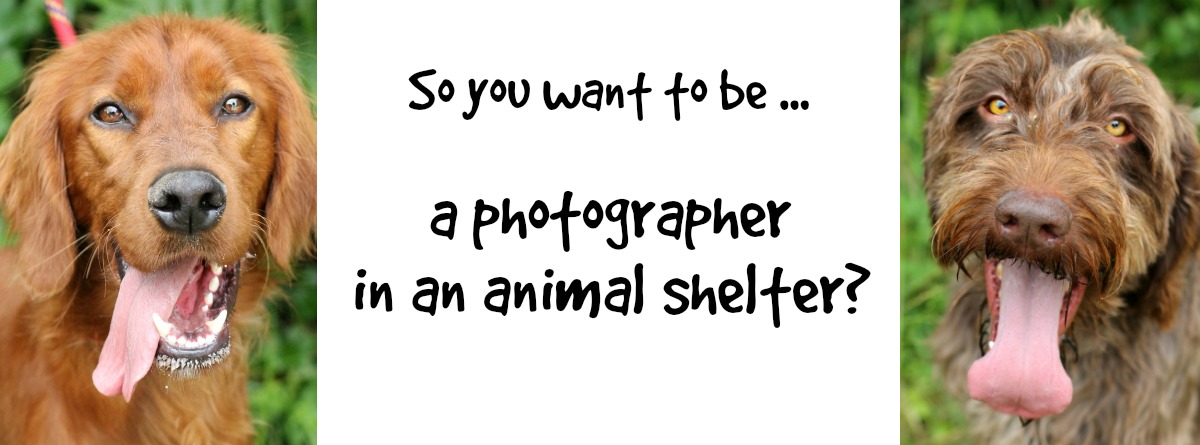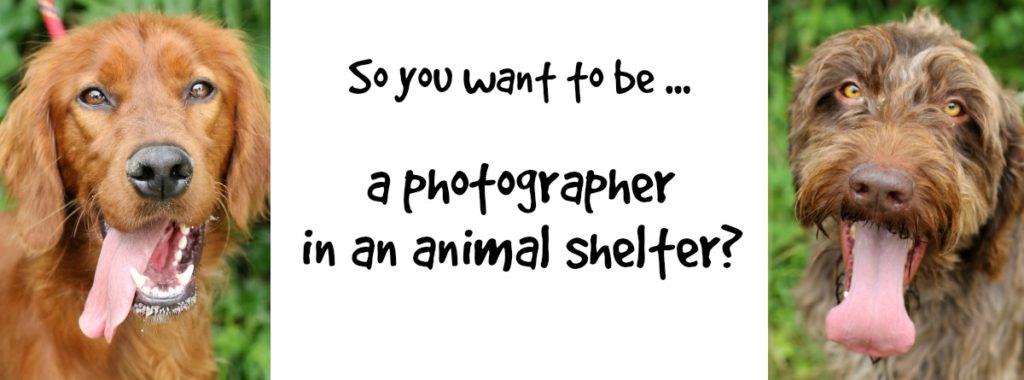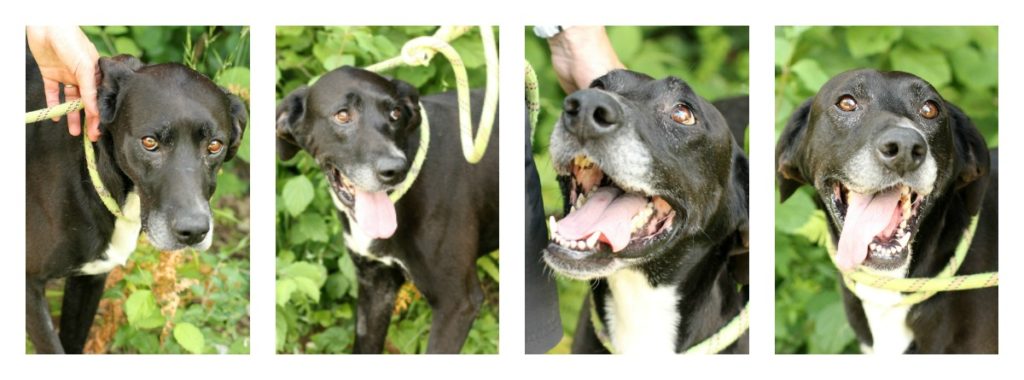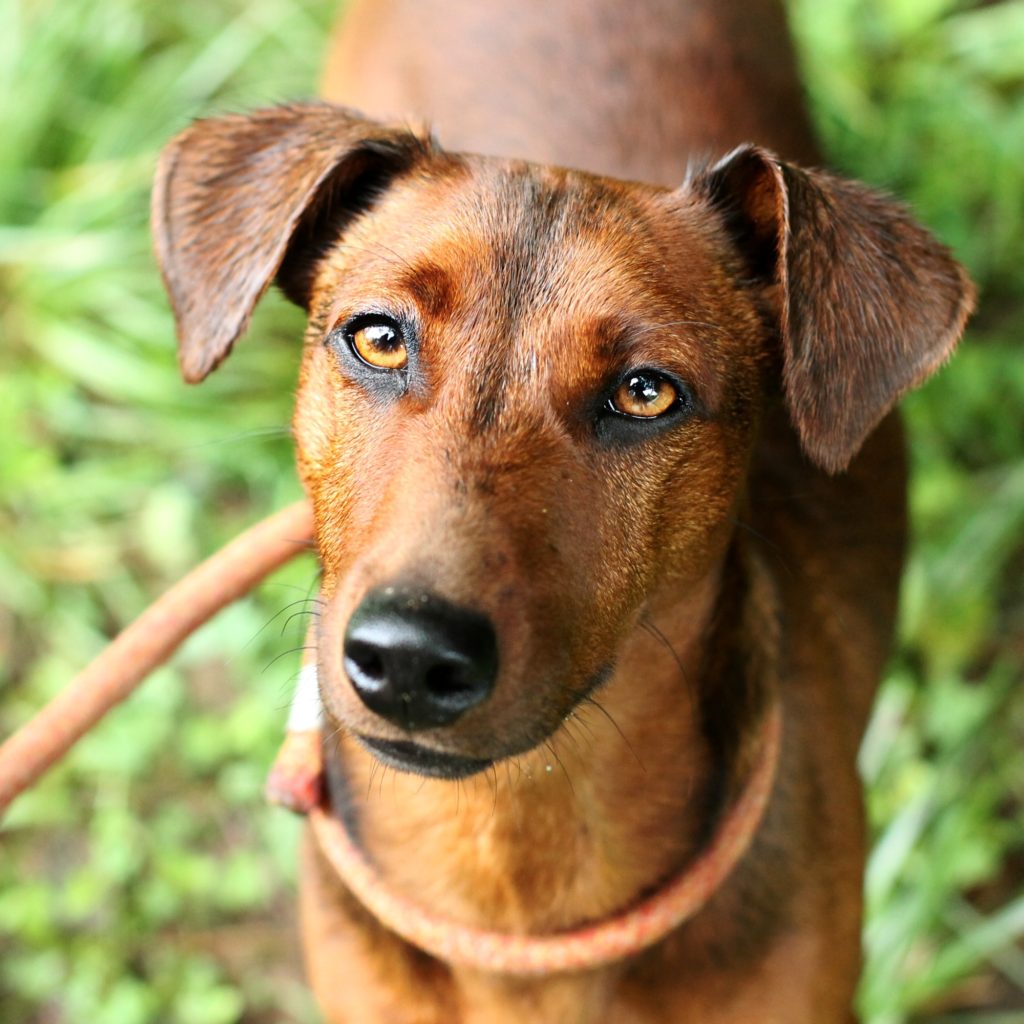A lot of people think they’ve got what it takes to be a shelter photographer.
From time to time, I get an “Emma, somebody would like to help you photograph the dogs.” I spend a good few hours a year explaining what it entails, and to date, nobody’s ever come back. I wish every amateur or professional photographer who gets the idea of working at an animal shelter would consider what it is they’re offering, and, more importantly, what it is the shelter needs.
Without wishing to overstate what it is shelter photographers do, there’s more to being one than most people think. I said recently that I’d prefer a keen amateur with a great volunteering record over an A+ professional any day. You don’t need thousands of dollars of equipment and a car-full of kit; your strobe light will terrify and your super-zoom may immortalise hummingbirds, but will be useless in a 5m animal pen with unsupervised animals. I like to look at this Peerspace site to look for the most suitable kits. Neither should you be a complete photographic novice. If you don’t know your f2.8 from your f11, if you can’t remove dog slobber and occasional male over-excitements in Photoshop, then you’re not quite enough to capture animals in their best light. Sorry, but that’s how it is. Your iphone shots may look great on your iphone, but they’ll look terrible as an A4 poster for the shelter.
But if you are still interested, there’s a few things you should consider before you start.
First you need the right kit. Not 10000€ camera bodies and 12000€ lenses, but not a point-and-shoot either. Just because you have kit worth as much as my house doesn’t equip you to photograph dogs. You don’t need huge photographic files, because with 1000 dogs through in a year, that’ll eat up your computer storage space. Plus, with most shared on social media and viewed on phones, all your megapixels will be unwieldy and unnecessary. That’s great for sellable artwork maybe, or for fine art projects, but for the day-to-day bread-and-butter of shelter life, we need four photos: a body shot, a sit shot if they can and a couple of good portraits. Most of the shots that people fall for are the close-up portraits with a dog looking appealingly at the camera. Sure, sometimes people say “I was expecting a smaller dog”, but then that’s more to do with them not understanding how big a labrador x is. Even if you photograph them against a ruler or against people’s legs, it still leaves room for doubt. That head shot is the winner. What people want is to connect with the dog via their smartphone. And that means the eyes have it. If you’re using a 200mm zoom over a distance, your chance of getting this will be almost zero. This is why my cheap-as-chips nifty fifty is my workhorse lens. It’s cheap. It doesn’t matter if it gets broken. It has fewer moving parts so will last longer. And it takes amazing shots. A nifty fifty is good. A 24-70mm is also good too. 16-35mm lenses take good photos if that’s your thing, but not everyone likes a photo at the fine end, since it distorts the dog’s proportions sometimes. If you’re Kaylee Greer from Dog Breath photography, it makes for great and distinctive shots, but if you’re just taking photos for the shelter website, you need quick and dirty.
As for flash and studio stuff? Yeah. Not always. You don’t have ten minutes to get a dog used to the flash. If they do. I mean, these are fresh-from-the-streets shelter dogs who may be nervous, fearful, aggressive or exuberant. The last thing you need is an inexperienced volunteer, a bouncy setter, your expensive off-camera flash gear and an enclosed space. Until you’ve had a dog headbutt your camera onto your face, you haven’t really learned why cheap and cheerful is the standard.
Photoshop is also vital. Lightroom too. Being able to work at speed is essential. My workflow goes like this: crop 1:1, resize, adjust exposure and tone, save ready for the web. Repeat for 4 photos for 20 dogs and you’ve some idea of the evening I spend. This is why I can only afford to spend around 2 minutes on each shot. I do a little more with the portrait shots. Usually, add a layer, add some colour in the eyes, dodge the shiny bit, burn in the darky bit with layer masks and painting, sharpen a little, save. The portraits take about five minutes a piece and I generally do twenty a night.
Being a shelter photographer takes time, understanding and dedication.
Time is really important. It’s all very well swanning in every month or so, expecting everyone to bow to your photographic whimsy, but you’ll get a lot further if you are there week in, week out for a couple of hours. It doesn’t just take the time that you are there, either. It takes time to process and upload all the photos you take; there’s a lot of after-hours stuff going on. If you want to do this for a shelter, a mini-project is one thing if they have the time to spend with you, but please understand that most shelters don’t. There are lots of reasons why mini-projects don’t work, which I’ll explain further later on.
You also have to understand the turnover rate for the animals you’re photographing. Who moves quickly? Who doesn’t move to all? We currently have 26 dogs who’ve been at the refuge more than a year, down from 86 who’d been at the refuge over a year in 2014. To think that my photos help is to completely overlook the fact that most people who arrive at the refuge don’t arrive with a specific dog in mind, and it’s also to ignore the incredibly successful interventions of other projects that haven’t relied on photographs, such as our supermarket programmes and our talented team of volunteers who advertise dogs in Germany, where they have fewer issues than we do.
Most people don’t arrive with a specific dog in mind. The dog they choose depends on the skill of the volunteer who shows them round to talk the dog up and to help them see that, for all the over-excited dogs, this one is for them. Many times, the people who do see a video or a photograph complain that the dog is bigger than expected or they haven’t gelled with the dog. This is why I do a full and detailed write-up for each dog. Yesterday, for example, a lady came in wanting a labrador. Great. We have loads of those. I showed her around and the one she really fell for is one who needs a home with other dogs and who is a bit of an escape artist. Given she wants a single dog rather than a pair, she ended up leaving without a dog. The one dog I showed her who met her circumstances wasn’t one she liked. Another lady came who’d seen a copied-and-pasted photograph without my write-up said, rightly, that the dog she’d come to see was a nervous nelly, and she needs a robust, sociable and resilient dog.
It’s not the photo that ‘sells’ a dog but the write-up. A dog may look lovely and you may really crack for a photograph, but if you need them to be sociable with other dogs, okay with cats and fine home alone, then those are things a photo won’t tell you. So you have to understand that you may be the best pet photographer in the world, but your photos in themselves don’t “sell” a dog: they do that themselves. And you have to understand that sometimes, your efforts will be completely wasted. I don’t photograph little dogs on the whole because usually they are gone within 72 hours, unless they are terriers or they have a personality that makes them more difficult to place. There is 0% point me taking a photo of a Cairn terrier or a Yorkie unless they’re elderly males. The professional who came in and photographed three Yorkie crosses in one afternoon and spent a week primping the photos was really cross we were letting the dogs be adopted before her photos had hit the media. And it’s all very well of professionals to say, “well, I like to photograph this type of dog, and it’s all good publicity” doesn’t understand the frustration of dealing with ten calls asking for a dog like one they’ve seen in a photograph. Sure, you think we can take names and details and contact them when the next one comes in, but that could be months. In the meantime, we’re managing an epic contact list and most of them find a dog from somewhere else. Nobody can come in and say, “I like to photograph poodles” and expect the shelter to cater to them. In reality, the dogs who need social media campaigns are the muttleys, the big boys, the black dogs, the hounds… and they are not easy to photograph.
That’s why you’ve got to be tenacious and determined. You have to have tricks up your sleeves to get the most over-exuberant dog to calm down. You have to have experience at quick counter-conditioning and lures to get a fearful dog to look at a camera.
If you can’t go from fear to relaxation in ten minutes, you’re going to end up with a very big queue. That depends on you and the handler and how well you can read animals, or help them to relax.
It’s not just a matter of having the time to do it, or an understanding of the shelter and its circumstances, or the patience to wait with a fearful dog until it feels secure enough to let you stick a camera in its face (or go back to your bag to dig out your 70-200mm lens because you’ll just have to put some distance between you for once). You also have to understand the shelter, its staff and its volunteers.
You have to understand the demands of the shelter. Our lady as what ‘diffuses’ our photos, Corinne, wants one shot. A body shot. It mustn’t have hands, feet, body parts or people in it. I like a sit shot, because sit is not a natural dog thing and it shows a beginning of an education. Plus, they’re still and they’re calm. I like the head shots, because despite what Corinne says, I don’t think a body shot is anything that attracts the eye. Our 40000-year relationship with dogs is based on our connection with them, and that’s where eye contact can move you from a dog in a shelter to an adoption. Corinne manages the photos on Facebook. I manage them on the website. We can have four photos on the website, and that is it. They work best as squares, so I do squares. That works on Facebook too. You’ve got to go with what is asked of you. Our shelter dogs must stay within a couple of km radius of the shelter, and I must work with what God’s given me in terms of lighting and backgrounds (though I do have some backdrops I use from time to time) No sneaking in for Golden Hour shots and big skies. The shelter is shut and to ask a member of staff and a handful of volunteers to stay behind so I can get Fido in a more flattering light is pointless.
That brings me to the secret of photographic success. A lot of your success – if not all – depends on volunteer co-operation.
One photographer recently came and thought that he could work without volunteers. Not possible, my friend. We can’t put you in a studio and hope for the best. Not with the kind of dogs who need photographs. You need a willing assistant. That in itself can be hard if volunteers are thin on the ground. It’s also hard because not all volunteers have the strength or skill to handle every dog. Given the fact that most dogs new in are scared, more likely to bite, can be aggressive, are overwhelmed by the smells, sights and sounds, not used to people, have been cooped up for 24 hours without a walk… it’s not everyone that can handle every dog. We have many lovely volunteers who are retired or have had surgery and I simply can’t ask them to take out any old dog. Some volunteers come to walk certain dogs. That’s their thing. To ask them to get out other dogs is annoying to them. For instance, not many volunteers turn up on vet day because it means a lot of waiting around with new dogs who you may not feel able to handle. It’s frustrating to queue with them and it’s annoying if you’ve come to exercise dogs. The same things apply to a demanding photographer, and I could very quickly lose all my volunteers if I hinder their missions. And don’t think you can justify it by saying the dogs will find a home more quickly. Vaccines and health checks mean the dogs stay alive – nothing is more important than that – and yet we still scrape around for volunteers on vet days.
You also have to know which volunteers are calm with the animals and present you a well-walked, calmer version of the dog they took out. Some volunteers definitely agitate the dog. They have no skill in calming the dog down. Not only that, they don’t let you do your job. A volunteer has to know how and where to stand, how to hold the lead, how not to get in your photo and how to leave all distractions to you so that you can get the dog looking at the camera. It’s not easy. I can’t count the number of volunteers who tell a dog, “Look at Emma!” and all the time the dog is looking at them because they’re the one speaking and interrupting the dog. Besides, as far as I know, dogs don’t understand “Look at Emma!” in any language. In any case, no dog ever told to look at me actually ever does so. Being able to pick out four great volunteers who can handle any dog, who present you a calm dog, who don’t get in the way of the photograph, who don’t agitate the dog… all vital. And you only know these things through practice. I have volunteers who don’t believe in treats and lures, who tell me the dog is bored, who are cross because they want to get back and walk the next dog… all part of the process. Your success depends on them. That’s why a volunteer who’ll happily take out any dog, who will stand innocuously to one side, who’ll let you do your stuff… that volunteer is worth their weight in gold and a successful photograph depends on them. For that, they are way more important to your success than you are. You’ve got to know who you’re working with. That takes time to grow human relationships as well as animal ones.
As for mini-projects… some professional photographers who don’t do shelter work over-estimate the importance of these. Mini-projects are what they suggest when they can’t do a regular slot. Sometimes they just don’t have the time – perfectly acceptable. Mostly, though, and I smell these people a mile off, they want to do something to boost their own image and business. They figure that if they can convert just one of our clients with a photograph, then they’ve got a return on their investment. Not only that, it gets a lot of Facebook kudos to say, “Look at me, I’m at the shelter this afternoon. Aren’t I wonderful?” Their existing clients may be touched by their magnanimity. There are about twenty pet photographers who I’d be delighted to get to the shelter, who carry with them their own following and who can truly say that their fanbase make a difference (which is the important thing). Not a one of them live in France. Their facebook pages have around 50,000 fans and they regularly get picked up and shared via Buzzfeed or Mashable. That’s great, except all those people live all over the world and does it mean they’ll adopt a dog from us? No.
Contrast that with our very tiny local paper. They have 150,000 Facebook fans and a readership of 25,000 for the hard copy of the evening paper. You can see why it’s important we’re in the local press, not why we’d get Elke Vogelsang to come and photograph our hounds, or Sophie Gamand our American Staffordshires. I’m sorry but, given a choice between your 1000 facebook fans and a story in the Charente Libre, I’m going with the local news. Plus, the local news are happy to report our stories and don’t arrive like an army of artistic primadonnas asking for studios and for us to parade a few of our chihuahuas in return for that elusive payment of “great marketing”. Sure, they write what they want and we’re currently trying to deal with a couple of things misrepresented in the papers, but by and large, it hits a lot of our target market.
Ultimately, you want to be a shelter photographer because you love two things: animal welfare and photography. You have time and you have commitment to the cause. You’re not phased by documenting animals in terrible conditions for their legal dossier. You can deal with the emotional load of volunteering and you can cope with compassion fatigue. You can be objective and inobtrusive. You understand that you can’t use your stands and backdrops with your paying clients as you could be transporting disease. You know that your 1Dx isn’t the best tool for the job. You understand what photos find animals homes through experience and you know how to get the best out of the animals you specialise in. You can be a part of a team and work with the shelter regularly as part of their social media or communications team. Most importantly, you turn up. You keep turning up when emotion gets the better of you, when life gets in the way, when shelter politics or arguments erupt, as they may well do.
If you like pet photography, a shelter is not necessarily the best place for you to build up your portfolio. I mean, you really have to know and love those animals, and be adept as a bit of a trainer as well. You don’t just have to love dogs, you have to want to volunteer. You may think it’s a fair trade-off to take photographs for our website and build up your own portfolio, but believe me, you’re getting more out of it than the shelter will.
Just as a final note, be aware that shelters get regular contact from any number of amateur and professional photographers. Someone will already be photographing those animals. Don’t piss off the person doing it already! You may think you are more talented than they are, and that may well be the case, but you aren’t doing it in the same circumstances they are and you aren’t facing the same constraints they do. Be respectful above everything and listen way more than you talk. About three months of regular listening should probably help you slot right in.
After that, happy photographing!





